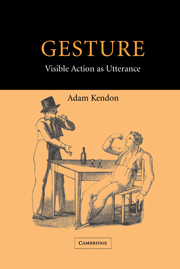Book contents
- Frontmatter
- Contents
- Acknowledgments
- 1 The domain of gesture
- 2 Visible action as gesture
- 3 Western interest in gesture from Classical Antiquity to the eighteenth century
- 4 Four contributions from the nineteenth century: Andrea de Jorio, Edward Tylor, Garrick Mallery and Wilhelm Wundt
- 5 Gesture studies in the twentieth century: recession and return
- 6 Classifying gestures
- 7 Gesture units, gesture phrases and speech
- 8 Deployments of gesture in the utterance
- 9 Gesture and speech in semantic interaction
- 10 Gesture and referential meaning
- 11 On pointing
- 12 Gestures of ‘precision grip’: topic, comment and question markers
- 13 Two gesture families of the open hand
- 14 Gesture without speech: the emergence of kinesic codes
- 15 ‘Gesture’ and ‘sign’ on common ground
- 16 Gesture, culture and the communication economy
- 17 The status of gesture
- Appendix I Transcription conventions
- Appendix II The recordings
- References
- Index
17 - The status of gesture
Published online by Cambridge University Press: 05 February 2015
- Frontmatter
- Contents
- Acknowledgments
- 1 The domain of gesture
- 2 Visible action as gesture
- 3 Western interest in gesture from Classical Antiquity to the eighteenth century
- 4 Four contributions from the nineteenth century: Andrea de Jorio, Edward Tylor, Garrick Mallery and Wilhelm Wundt
- 5 Gesture studies in the twentieth century: recession and return
- 6 Classifying gestures
- 7 Gesture units, gesture phrases and speech
- 8 Deployments of gesture in the utterance
- 9 Gesture and speech in semantic interaction
- 10 Gesture and referential meaning
- 11 On pointing
- 12 Gestures of ‘precision grip’: topic, comment and question markers
- 13 Two gesture families of the open hand
- 14 Gesture without speech: the emergence of kinesic codes
- 15 ‘Gesture’ and ‘sign’ on common ground
- 16 Gesture, culture and the communication economy
- 17 The status of gesture
- Appendix I Transcription conventions
- Appendix II The recordings
- References
- Index
Summary
What is the status of gesture? On the one hand it has been valued as a component of self-presentation and public performance, even cultivated as an art. On the other hand, it has been looked upon as something to be avoided, its use betraying a lack of proper self-control or an inadequate command of spoken language. At times it has been deemed worthy of scholarly attention and analysis, being viewed as a phenomenon of theoretical and philosophical importance for the light its study might throw on the nature of language, symbolic processes and expression. At other times scholars have paid it scant attention, it being dismissed as a superficial ephemera of no importance.
As we saw from our historical survey of interest in gesture in the West (Chapters 3-6), at least since the time of Quintilian, nearly 2000 years ago, gesture has been recognized as a component of human utterance. Quintilian saw it as a natural companion of speech, however he believed that it should be refined and shaped in accordance with rules and principles that would ensure that it would be an effective part of the rhetorician 's art. Gestures were seen as enriching and elaborating the audience 's experience of the orator 's speech, and if not performed correctly and with proper decorum they could have seriously negative consequences.
- Type
- Chapter
- Information
- GestureVisible Action as Utterance, pp. 355 - 361Publisher: Cambridge University PressPrint publication year: 2004

